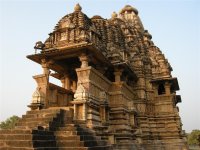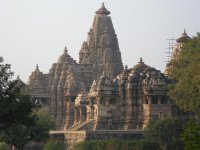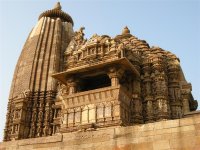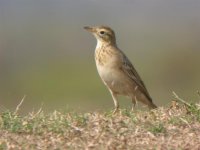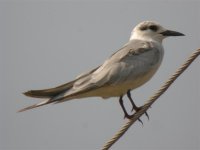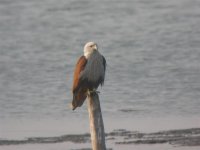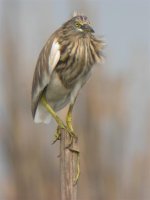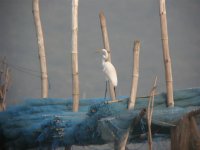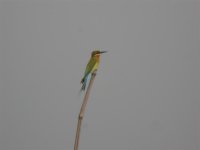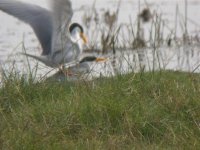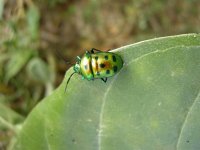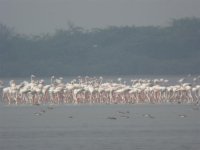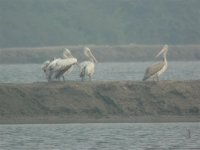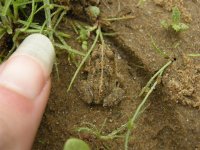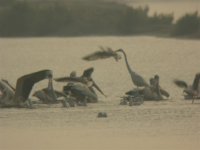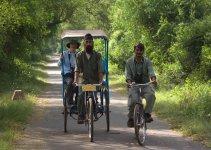-
Welcome to BirdForum, the internet's largest birding community with thousands of members from all over the world. The forums are dedicated to wild birds, birding, binoculars and equipment and all that goes with it.
Please register for an account to take part in the discussions in the forum, post your pictures in the gallery and more.
You are using an out of date browser. It may not display this or other websites correctly.
You should upgrade or use an alternative browser.
You should upgrade or use an alternative browser.
INDIA (independant and on a budget) 10/11/09 to 16/01/10 (1 Viewer)
- Thread starter richard jb
- Start date
More options
Who Replied?Steve Babbs
Well-known member
Good to know there are still a few people out there able to do trips without a guide/being on a tour. It's nearly 20 years since I was there getting very frustated trying to id birds with 'pictorial guide'. I totally understand the banging your head against a wall coment. It's by far the most stressful place I've ever been but very rewarding both wildlife wise and for its amazing culture and history.
VC65_Birder
Well-known member
Probable Banded Bay Cuckoo (prolonged but quite poor view)
A very brief view of a pale Pheasant darting between two bushes, I called pheasant, convinced it wasn't Kalij but we never saw it again. I don't know if Cheer Pheasant are present at Sat Tal as it may not be high enough?
Hi Richard - great thread, loving the memories!
Unfortunately, my understanding is that Sat Tal isn't high enough for Cheers - need to go up to Pangot for that. We had 2 Kalij's at Sat Tal when we were there (we also had a Banded Bay Cuckoo there, behind the tea shops next to the lake, where we also had a male Golden Bush Robin!)
richard jb
Well-known member
great thread & pics.
If you get the chance please title your pics with species.
Thanks for sharing.
Mick:t:
Pictures so far:
1.) Short Toed Snake Eagle
2.) Wood Sandpiper
3.) Grey Headed Plover
4.) Greenshank
5.) Large Tailed Nightjar
6.) White Throated Kingfisher
7.) Spotted Owlet
8.) Black Necked Stork
9.) White Eyed Buzzard
10.) Painted Snipe
11.) Collared Falconet
12.) Tawny Fish Owl (calling)
13.) Pallas's Fish Eagle
14.) Smooth Coated Otters
15.) Lesser Fish Eagle
16.) Brown Fish Owl
17.) Corbett
18.) Monitor Lizard
19.) Weaver sp. nests
20.) Changeable Hawk Eagle
21.) Crested Kingfisher
22.) Ibisbill
23.) Garjiya Temple
24.) Kosi River from Ramnagar damn/bridge
25.) Wallcreeper
26.) "Freaky Falls", Ghatgar
27.) Striated Heron
28.) Himalayas
29.) Steppe Eagles
30.) Grey Backed Shrike
31.) Southern Grey Shrike
32.) Black Bulbul
33.) Chestnut Crowned Laughingthrush
34.) Ashy Drongo
35.) Leopard scat
36.) Common Rosefinch
37.) Mongoli
38.) Leopard print
39.) clawing post
40.) Rusty Cheeked Scimitar Babbler
41.) Greater Flameback
42.) Red Breasted Parakeet
43.) Asian Barred Owlet
44.) Rusty Cheeked Scimitar Babbler
Unfortunately, my understanding is that Sat Tal isn't high enough for Cheers - need to go up to Pangot for that. We had 2 Kalij's at Sat Tal when we were there (we also had a Banded Bay Cuckoo there, behind the tea shops next to the lake, where we also had a male Golden Bush Robin!)
I thought it was a bit low for them. It's a pity I didn't have time to do much research pre-trip as we only found out about Pangot on our last day in the area.
We missed Golden Bush Robin, despite a lot of lingering in supposed favoured spots. Did you use a tape?
VC65_Birder
Well-known member
We missed Golden Bush Robin, despite a lot of lingering in supposed favoured spots. Did you use a tape?
No tape - we were lucky the winter we went as a male was wintering in the bushes behind the Chai stands next to the lake - it became quite a celeb, and a Tim Loseby photo of it taken the day before we arrived was used on the front cover of the OBC's mag a few years ago! - http://www.orientalbirdclub.org/assets/basia/ba3cover.jpg
richard jb
Well-known member
No tape - we were lucky the winter we went as a male was wintering in the bushes behind the Chai stands next to the lake - it became quite a celeb, and a Tim Loseby photo of it taken the day before we arrived was used on the front cover of the OBC's mag a few years ago! - http://www.orientalbirdclub.org/assets/basia/ba3cover.jpg
Stunning bird. It's always good to leave a couple for the next trip though?!
Larry Sweetland
Formerly 'Larry Wheatland'
Good to know there are still a few people out there able to do trips without a guide/being on a tour.
Is it really that bad now? I must admit I've been bumping into more tour groups than independent birders lately. Great to read this thread.
Last edited:
richard jb
Well-known member
Is it really that bad now? I must admit I've been bumping into more tour groups than independent birders lately. Great to read this thread.
We spent 10 weeks in India and visited plenty of well known sites. We only met 4 other independent birders (3 at Bharatpur and 1 at Corbett). Everyone else was on a tour. It didn't look like my idea of fun...
richard jb
Well-known member
5/12 - 13/12
As this wasn't exclusively a birding trip we decided to head to Khajuraho next, and after a couple of nights on trains and a bus journey we arrived. The sandstone temples here are phenomenal and well worth the trip.
Accommodation here is cheap and the small town is geared up for tourists while managing to be quiet and fairly hassle free. The usual common birds, including Indian Grey Hornbill, Coppersmith Barbet and Red Breasted Flycatcher can be found in trees and scrub around the temples. Brown Rock Chats are common.
Our next stop was Varanasi. We arrived at 3am after a horrendous overnight bus journey involving changes at truck stops. The train was fully booked for days as Varanasi is a big tourist stop.
We made our way down to the ghats and watched a Spotted Owlet hunt until it got light. Pied Kingfisher and White Browed Wagtail were common. We didn't enjoy Varanasi at all. It's notorious for hassle and conmen but we got very little attention. It's famous for being a vibrant, atmospheric, holy centre of Hinduism but we saw little of this. It felt a bit like Indiadisneyland. The Ganges is in a sorry state here, I don't know if Gangetic Dolphin is still present but we saw no sign.
We saw caged birds for sale for the first time.
From Varanasi we took a train to Gaya, and then travelled on to Bodhgaya, which is famous for being the place of Gautama Buddha's attainment of nirvana (enlightenment). There was an international chanting ceremony on while we were there. By this point I was well and truly fed up with the lack of birding, but this area showed some promise, and even provided some new birds.
Asian Koel
Palm Swift
Brown Headed Barbet
Eurasian Golden Oriole
Asian Openbill
Possible Slender Billed Oriole (it didn't call so I wouldn't claim it, despite noting a down curved bill. I didn't have my field guide at the time and wasn't aware of the distinguishing features from Black Naped Oriole)
Bodhgaya itself is another 'holy' town full of tourists and all of the negative elements they inevitably attract in India.
A man attempted to sell us some fledgling Scaly Breasted Munias out of a small cage. I admit to letting off a little steam after biting my lip during various unpleasant situations over the past few days (Italian junkies, the constant arm/hand grabbing by beggars, an attempted theft, a petrol bomb+riot situation etc). It fell on deaf ears and he ran away in the end.
Our next stop was to be Chilka Lake in Orissa. Our train was 2, then 8, then 12 then 19 hours late. Gaya is not the kind of place you want to be stuck. At one point a crowd of about 40 men gathered around to stare, completely encircling us. It's fair to say there are more bad than good stories from this section of our trip, so I'll move on now! There may be some excellent, undiscovered birding in this region but I wasn't keen on finding out...
As this wasn't exclusively a birding trip we decided to head to Khajuraho next, and after a couple of nights on trains and a bus journey we arrived. The sandstone temples here are phenomenal and well worth the trip.
Accommodation here is cheap and the small town is geared up for tourists while managing to be quiet and fairly hassle free. The usual common birds, including Indian Grey Hornbill, Coppersmith Barbet and Red Breasted Flycatcher can be found in trees and scrub around the temples. Brown Rock Chats are common.
Our next stop was Varanasi. We arrived at 3am after a horrendous overnight bus journey involving changes at truck stops. The train was fully booked for days as Varanasi is a big tourist stop.
We made our way down to the ghats and watched a Spotted Owlet hunt until it got light. Pied Kingfisher and White Browed Wagtail were common. We didn't enjoy Varanasi at all. It's notorious for hassle and conmen but we got very little attention. It's famous for being a vibrant, atmospheric, holy centre of Hinduism but we saw little of this. It felt a bit like Indiadisneyland. The Ganges is in a sorry state here, I don't know if Gangetic Dolphin is still present but we saw no sign.
We saw caged birds for sale for the first time.
From Varanasi we took a train to Gaya, and then travelled on to Bodhgaya, which is famous for being the place of Gautama Buddha's attainment of nirvana (enlightenment). There was an international chanting ceremony on while we were there. By this point I was well and truly fed up with the lack of birding, but this area showed some promise, and even provided some new birds.
Asian Koel
Palm Swift
Brown Headed Barbet
Eurasian Golden Oriole
Asian Openbill
Possible Slender Billed Oriole (it didn't call so I wouldn't claim it, despite noting a down curved bill. I didn't have my field guide at the time and wasn't aware of the distinguishing features from Black Naped Oriole)
Bodhgaya itself is another 'holy' town full of tourists and all of the negative elements they inevitably attract in India.
A man attempted to sell us some fledgling Scaly Breasted Munias out of a small cage. I admit to letting off a little steam after biting my lip during various unpleasant situations over the past few days (Italian junkies, the constant arm/hand grabbing by beggars, an attempted theft, a petrol bomb+riot situation etc). It fell on deaf ears and he ran away in the end.
Our next stop was to be Chilka Lake in Orissa. Our train was 2, then 8, then 12 then 19 hours late. Gaya is not the kind of place you want to be stuck. At one point a crowd of about 40 men gathered around to stare, completely encircling us. It's fair to say there are more bad than good stories from this section of our trip, so I'll move on now! There may be some excellent, undiscovered birding in this region but I wasn't keen on finding out...
Attachments
richard jb
Well-known member
14/12 - 16/12 Chilka Lake (Satapada)
We arrived in Puri and marched straight to the bus station. I was not keen on hanging around in another temple orientated tourist town! We quickly found a bus bound for Satapada on the shores of Chilka Lake. Although it's only a short journey (50km) the trip took over 3 hours and was very uncomfortable thanks to the heat and excessive (even by Indian standards) overcrowding. The bus stopped every 50-100m to pick people up which is incredibly frustrating, and prevents any real air flow through the bus. Plenty of taxis and rickshaws ply this route, but it would cost a lot more than 5Rs...
Satapada itself is home to a visitor centre, a few food and drink stalls, one restaurant and a hotel run by Orissa Tourism. The hotel is not good value at 400Rs a night but there is no alternative. The hotel restaurant is expensive and nowhere near as good as the very cheap and friendly place in the village. The visitor center is surprisingly good and only costs 10Rs. They also sell a range of literature on Chilka Lake.
Most of our birding around Satapada was done on foot, walking east from the village out along the lake shore paths. These are well used by locals who will be very interested in you. We quickly became well known, and after a while the constant requests for a look through my telescope died down. The birding here is quite good, and Irawaddy Dolphin can sometimes be seen.
On our second day here we decided to treat ourselves to a boat trip. It was very expensive (700Rs for 2 hours) but I really wanted to see Irawaddy Dolphins and more of the lake. Our driver spoke no English whatsoever so looking for birds was off the agenda.
We stopped after 20 minutes and were boarded by fishermen trying to sell us prawns and pearls. Another 30 minutes (we had steamed past 1000's of Pintail) took us to the beach where we landed and were instantly set upon by restaurant owners telling us we had to eat fried fish and feed our boat driver. I'd had enough by now so stormed off to dip my toe in the Bay of Bengal. We found 3 dead (Olive Ridley?) Turtles here, Sanderling, Kentish Plover and Lesser Sand Plover.
On the way back our driver seemed in a hurry, and was rubbing his stomach a lot making out that he wanted to get home and eat. I spotted a couple of Irawaddy Dolphins close by and managed to get him to stop for all of a minute or so to look at them. Then, after demands for money (?!) he decided it was time to leave. There were then demands for a tip when we got back!
It is worth mentioning that this trip was done through 'Dolphin Motor Boat Association' which is a co-op of fishermen. There is no alternative for a short trip.
Some birds seen around Satapada and from the boats:
Gadwall
Tufted Duck
Pintail
Lesser Whistling Duck
White Bellied Sea Eagle
Booted Eagle
Osprey
Brahminy Kite
Paddyfield Pipit
Buff Breasted Pipit
Richards Pipit
Citrine Wagtail
Yellow Wagtail
Pacific Golden Plover
Little Ringed Plover
Kentish Plover
Lesser Sand Plover
Sanderling
Wood, Marsh, Common Sandpipers
Temmincks Stint
Little Stint
Snipe
Curlew
Whimbrel
Black Tailed Godwit
Bar Tailed Godwit
Oriental Skylark
Baya Weaver
Blue Tailed Bee-eater
Pheasant Tailed Jacana
Whiskered Tern
Caspian Tern
White Winged Black Tern
River Tern
Herons and Egrets
The next day we took the small ferry to Balugaon, 3 hours away. This only cost us 30Rs. From the ferry we saw hundreds of Irawaddy Dolphins and had great views of Ospreys hunting and Caspian Terns. The highlight though was the huge rafts of wildfowl composed of hundreds of thousands of Pochard, Tufted Duck, Gadwall, Wigeon and Coots. There may have been something scarce in there but the ferry wasn't about to stop for us... Regardless, if you want to see Chilka Lake by boat this ferry is probably the best way to do it.
We arrived in Puri and marched straight to the bus station. I was not keen on hanging around in another temple orientated tourist town! We quickly found a bus bound for Satapada on the shores of Chilka Lake. Although it's only a short journey (50km) the trip took over 3 hours and was very uncomfortable thanks to the heat and excessive (even by Indian standards) overcrowding. The bus stopped every 50-100m to pick people up which is incredibly frustrating, and prevents any real air flow through the bus. Plenty of taxis and rickshaws ply this route, but it would cost a lot more than 5Rs...
Satapada itself is home to a visitor centre, a few food and drink stalls, one restaurant and a hotel run by Orissa Tourism. The hotel is not good value at 400Rs a night but there is no alternative. The hotel restaurant is expensive and nowhere near as good as the very cheap and friendly place in the village. The visitor center is surprisingly good and only costs 10Rs. They also sell a range of literature on Chilka Lake.
Most of our birding around Satapada was done on foot, walking east from the village out along the lake shore paths. These are well used by locals who will be very interested in you. We quickly became well known, and after a while the constant requests for a look through my telescope died down. The birding here is quite good, and Irawaddy Dolphin can sometimes be seen.
On our second day here we decided to treat ourselves to a boat trip. It was very expensive (700Rs for 2 hours) but I really wanted to see Irawaddy Dolphins and more of the lake. Our driver spoke no English whatsoever so looking for birds was off the agenda.
We stopped after 20 minutes and were boarded by fishermen trying to sell us prawns and pearls. Another 30 minutes (we had steamed past 1000's of Pintail) took us to the beach where we landed and were instantly set upon by restaurant owners telling us we had to eat fried fish and feed our boat driver. I'd had enough by now so stormed off to dip my toe in the Bay of Bengal. We found 3 dead (Olive Ridley?) Turtles here, Sanderling, Kentish Plover and Lesser Sand Plover.
On the way back our driver seemed in a hurry, and was rubbing his stomach a lot making out that he wanted to get home and eat. I spotted a couple of Irawaddy Dolphins close by and managed to get him to stop for all of a minute or so to look at them. Then, after demands for money (?!) he decided it was time to leave. There were then demands for a tip when we got back!
It is worth mentioning that this trip was done through 'Dolphin Motor Boat Association' which is a co-op of fishermen. There is no alternative for a short trip.
Some birds seen around Satapada and from the boats:
Gadwall
Tufted Duck
Pintail
Lesser Whistling Duck
White Bellied Sea Eagle
Booted Eagle
Osprey
Brahminy Kite
Paddyfield Pipit
Buff Breasted Pipit
Richards Pipit
Citrine Wagtail
Yellow Wagtail
Pacific Golden Plover
Little Ringed Plover
Kentish Plover
Lesser Sand Plover
Sanderling
Wood, Marsh, Common Sandpipers
Temmincks Stint
Little Stint
Snipe
Curlew
Whimbrel
Black Tailed Godwit
Bar Tailed Godwit
Oriental Skylark
Baya Weaver
Blue Tailed Bee-eater
Pheasant Tailed Jacana
Whiskered Tern
Caspian Tern
White Winged Black Tern
River Tern
Herons and Egrets
The next day we took the small ferry to Balugaon, 3 hours away. This only cost us 30Rs. From the ferry we saw hundreds of Irawaddy Dolphins and had great views of Ospreys hunting and Caspian Terns. The highlight though was the huge rafts of wildfowl composed of hundreds of thousands of Pochard, Tufted Duck, Gadwall, Wigeon and Coots. There may have been something scarce in there but the ferry wasn't about to stop for us... Regardless, if you want to see Chilka Lake by boat this ferry is probably the best way to do it.
Attachments
Last edited:
Birdingcraft
Well-known member
Great read! Thanks for posting about your trip.
richard jb
Well-known member
17/12 - 20/12 Chilka Lake (Barkul area)
Balugaon is not a particularly nice town but it does have an internet cafe, a small train station and a couple of really cheap places to stay. It is on the lake shore but we didn't attempt any birding around here.
After finding all of the trains out of Orissa were fully booked for a month we resigned ourselves to spending a day sorting out tickets in the capital, Bhubaneswar. We managed to get a ticket in the tourist quota to Tiruchirapalli. From here we could travel on to Pt Calimere using local trains and buses.
With our onward travel sorted we got back to birding. Nalabana Island is the best birdwatching area on Chilka Lake, and Barkul is the best place to organise a boat trip from. Shared taxis run between Balugaon and Barkul, just flag them down (should cost 10Rs, a private taxi is 70Rs if you haggle).
We arrived in Barkul and took a room in one of the lodges away from the lake shore (250Rs a night). A lot of people come through Barkul to visit the Kalijai Temple and it can get really busy at times. They don't stray from the village though, just get off the coach and onto a boat. We did a bit of birding along the lake shore but it wasn't as productive as Satapada and there are some aggressive dogs around (it's worth going for a walk in the evening to see the fruit bats though).
We asked at the government hotel about boat trips, stating that we wanted to land on Nalabana. We were told their trips just circle the island, so we decided to organise our own. We went down to the jetties and started asking around. Eventually someone who spoke English arranged us a boat for 4 hours to include 2 hours on Nalabana Island. We were all set to leave at 0530 the next morning.
When we got to the boat the next day we were informed of a slight change in plans, we couldn't actually land on Nalabana as we needed permits. We could still get close and "see all the migratory birds" though. After some umming and ahhhing about paying 1000RS and not getting to land we decided to go for it anyway, thinking we should still see plenty and may be able to scope some waders.
Our boat crew was an old man and a young boy (neither spoke any English), our interpreter stayed on the jetty. We motored out towards Nalabana with our driver charging into every flock of waterfowl we came across, flushing them, then chasing them down again. It took quite a few sign language attempts to convince him to stop. Eventually Nalabana came into view. There were birds everywhere (albeit specks on the horizon).
Then we stopped. Huge poles mark out the restricted area around Nalabana, which is 3km off its bird rich shores. A speed boat with guards was racing around inside the restricted zone at about 30mph for no apparent reason. We saw a White Bellied Sea Eagle take a duck and through the scope I could just about make out some Bar Headed Geese and Flamingos feeding. This was as good as it was going to get. We could go no further.
All hell broke out when we got back and our interpreter tried to charge us the 1000Rs for our boat trip. I told him I'd give him 500RS and he should consider himself lucky. It took over an hour but we convinced him eventually.
As we still had time we decided to try and get a permit. The boatmen told us we had to go to Delhi but I didn't believe them. We asked at the government run hotel. The staff here were typically unmotivated but we kept pestering them until they told us we could get a permit in Balugaon, and then it would be 'no problem' to land on Nalabana. This lifted our spirits, and we jumped straight in a shared rickshaw. On arrival in Balugaon we eventually found the 'Chilka Lake Wildlife Office' who issue permits. Or I should say issued permits. In 2004. We were told we had to go to Bhubaneswar. At this point we gave up, we wouldn't be able to get there in time.
I don't know if you can actually get permits in Bhubaneswar. It would pay to make inquiries before you go if you were going to try. I wouldn't really recommend Chilka Lake if you can't get a permit for Nalabana. There may be other good areas, but I doubt they are easily accessible.
If you want to see Irrawady Dolphins and plenty of birds on a day trip (from Puri for example) I would get to Satapada for early morning birding along the lake shore, then get the ferry to Balugaon in the afternoon and travel on from there.
The next day we took a bus to Rambha at the southern end of the lake. This area was very pleasant but quiet bird wise.
More Birds:
Bar Headed Goose
Asian Openbill (large flocks from the Balugaon - Bhubaneswar train)
Purple Gallinule
Barn Swallow
Yellow Legged Gull
Hueglins Gull
Clamorous Reed Warbler
Flamingo sp. (many, but too distant to ID)
Balugaon is not a particularly nice town but it does have an internet cafe, a small train station and a couple of really cheap places to stay. It is on the lake shore but we didn't attempt any birding around here.
After finding all of the trains out of Orissa were fully booked for a month we resigned ourselves to spending a day sorting out tickets in the capital, Bhubaneswar. We managed to get a ticket in the tourist quota to Tiruchirapalli. From here we could travel on to Pt Calimere using local trains and buses.
With our onward travel sorted we got back to birding. Nalabana Island is the best birdwatching area on Chilka Lake, and Barkul is the best place to organise a boat trip from. Shared taxis run between Balugaon and Barkul, just flag them down (should cost 10Rs, a private taxi is 70Rs if you haggle).
We arrived in Barkul and took a room in one of the lodges away from the lake shore (250Rs a night). A lot of people come through Barkul to visit the Kalijai Temple and it can get really busy at times. They don't stray from the village though, just get off the coach and onto a boat. We did a bit of birding along the lake shore but it wasn't as productive as Satapada and there are some aggressive dogs around (it's worth going for a walk in the evening to see the fruit bats though).
We asked at the government hotel about boat trips, stating that we wanted to land on Nalabana. We were told their trips just circle the island, so we decided to organise our own. We went down to the jetties and started asking around. Eventually someone who spoke English arranged us a boat for 4 hours to include 2 hours on Nalabana Island. We were all set to leave at 0530 the next morning.
When we got to the boat the next day we were informed of a slight change in plans, we couldn't actually land on Nalabana as we needed permits. We could still get close and "see all the migratory birds" though. After some umming and ahhhing about paying 1000RS and not getting to land we decided to go for it anyway, thinking we should still see plenty and may be able to scope some waders.
Our boat crew was an old man and a young boy (neither spoke any English), our interpreter stayed on the jetty. We motored out towards Nalabana with our driver charging into every flock of waterfowl we came across, flushing them, then chasing them down again. It took quite a few sign language attempts to convince him to stop. Eventually Nalabana came into view. There were birds everywhere (albeit specks on the horizon).
Then we stopped. Huge poles mark out the restricted area around Nalabana, which is 3km off its bird rich shores. A speed boat with guards was racing around inside the restricted zone at about 30mph for no apparent reason. We saw a White Bellied Sea Eagle take a duck and through the scope I could just about make out some Bar Headed Geese and Flamingos feeding. This was as good as it was going to get. We could go no further.
All hell broke out when we got back and our interpreter tried to charge us the 1000Rs for our boat trip. I told him I'd give him 500RS and he should consider himself lucky. It took over an hour but we convinced him eventually.
As we still had time we decided to try and get a permit. The boatmen told us we had to go to Delhi but I didn't believe them. We asked at the government run hotel. The staff here were typically unmotivated but we kept pestering them until they told us we could get a permit in Balugaon, and then it would be 'no problem' to land on Nalabana. This lifted our spirits, and we jumped straight in a shared rickshaw. On arrival in Balugaon we eventually found the 'Chilka Lake Wildlife Office' who issue permits. Or I should say issued permits. In 2004. We were told we had to go to Bhubaneswar. At this point we gave up, we wouldn't be able to get there in time.
I don't know if you can actually get permits in Bhubaneswar. It would pay to make inquiries before you go if you were going to try. I wouldn't really recommend Chilka Lake if you can't get a permit for Nalabana. There may be other good areas, but I doubt they are easily accessible.
If you want to see Irrawady Dolphins and plenty of birds on a day trip (from Puri for example) I would get to Satapada for early morning birding along the lake shore, then get the ferry to Balugaon in the afternoon and travel on from there.
The next day we took a bus to Rambha at the southern end of the lake. This area was very pleasant but quiet bird wise.
More Birds:
Bar Headed Goose
Asian Openbill (large flocks from the Balugaon - Bhubaneswar train)
Purple Gallinule
Barn Swallow
Yellow Legged Gull
Hueglins Gull
Clamorous Reed Warbler
Flamingo sp. (many, but too distant to ID)
Attachments
Last edited:
richard jb
Well-known member
23/12 - 26/12 Pt Calimere (Kodikkarai)
It took us a few days to get down to Pt Calimere, including a 39 hour stint on a train. Kodikkarai is well off the beaten track and there were Tamil Tiger related problems in the area until very recently. There is now a (temporary?) military base but this hasn't affected access.
There is a forest rest house in Kodikkarai itself which is the most convenient place to stay, and excellent value (100Rs for a double with bathroom). Eating is an issue here though, and it is best to bring supplies. There is small shop/supermarket in the village which may disappear if the military pull out. The FRH has a checklist of birds on the wall and there is a migration study building which we didn't have time to check out. There may be some ringing going on.
Unfortunately we could only stay here one night as the whole hotel had been booked out by an Indian family. I think it's normally fairly empty. We moved to Vedaranyam which is the nearest town. There is a good supermarket and one hotel (dingy with cockroaches, 200Rs/night). There is a very frequent bus to Kodikkarai which takes about 30mins and apparently runs from 4am. In practice 6am is more realistic.
The reserve itself is vast but best explored on foot. Things have changed since the birdwatchers guide was published but the map is still useful when getting your bearings. There had been a lot of rain prior to our arrival and the main reserve was badly flooded, preventing access to certain areas. We found the salt pans to be the most productive/spectacular area although there are birds everywhere. We frequently found ourselves waist deep in water getting around (and not just due to recent flooding) so dress accordingly.
Some interesting/new Birds...
Pied Cuckoo
Blue Faced Malkoha
Black Naped Oriole (not on the FRH checklist...)
Eurasian Golden Oriole
Purple Rumped Sunbird
Long Tailed Shrike (ssp caniceps)
Brown Shrike
Yellow Billed Babbler
Rosy Starling
Blyths Reed Warbler
Western Reef Egret
Pallas's/Great Black Headed Gull
Heuglins Gull
Slender Billed Gull
Little Tern
Common Tern
Sandwich Tern
poor view of a probable Bridled Tern
Spoonbill
Greater Flamingo
Spot Billed Pelican
Huge numbers of waders. Who knows how many Spoon Billed Sandpipers could be hidden away?
Dunlin
Curlew Sandpiper
Broad Billed Sandpiper
Terek Sandpiper
Kentish, Little Ringed, Greater Sand, Lesser Sand Plover
Temmincks and Little Stint
Green, Wood, Marsh, Common Sanpiper
Spotted Redshank, Redshank
Black Tailed Godwit
Ruff
Red Necked Phalarope
A boat would be useful to get to some of the best looking areas for waders, including potential Crab Plover sites. We also saw Bottlenose Dolphins every day and Blackbuck are very common.
Pt Calimere is not the easiest of sites. It's big, exposed, undeveloped and birds can be distant with good viewing areas inaccessible. We barely scratched the surface though. The good areas are worth multiple visits.
It took us a few days to get down to Pt Calimere, including a 39 hour stint on a train. Kodikkarai is well off the beaten track and there were Tamil Tiger related problems in the area until very recently. There is now a (temporary?) military base but this hasn't affected access.
There is a forest rest house in Kodikkarai itself which is the most convenient place to stay, and excellent value (100Rs for a double with bathroom). Eating is an issue here though, and it is best to bring supplies. There is small shop/supermarket in the village which may disappear if the military pull out. The FRH has a checklist of birds on the wall and there is a migration study building which we didn't have time to check out. There may be some ringing going on.
Unfortunately we could only stay here one night as the whole hotel had been booked out by an Indian family. I think it's normally fairly empty. We moved to Vedaranyam which is the nearest town. There is a good supermarket and one hotel (dingy with cockroaches, 200Rs/night). There is a very frequent bus to Kodikkarai which takes about 30mins and apparently runs from 4am. In practice 6am is more realistic.
The reserve itself is vast but best explored on foot. Things have changed since the birdwatchers guide was published but the map is still useful when getting your bearings. There had been a lot of rain prior to our arrival and the main reserve was badly flooded, preventing access to certain areas. We found the salt pans to be the most productive/spectacular area although there are birds everywhere. We frequently found ourselves waist deep in water getting around (and not just due to recent flooding) so dress accordingly.
Some interesting/new Birds...
Pied Cuckoo
Blue Faced Malkoha
Black Naped Oriole (not on the FRH checklist...)
Eurasian Golden Oriole
Purple Rumped Sunbird
Long Tailed Shrike (ssp caniceps)
Brown Shrike
Yellow Billed Babbler
Rosy Starling
Blyths Reed Warbler
Western Reef Egret
Pallas's/Great Black Headed Gull
Heuglins Gull
Slender Billed Gull
Little Tern
Common Tern
Sandwich Tern
poor view of a probable Bridled Tern
Spoonbill
Greater Flamingo
Spot Billed Pelican
Huge numbers of waders. Who knows how many Spoon Billed Sandpipers could be hidden away?
Dunlin
Curlew Sandpiper
Broad Billed Sandpiper
Terek Sandpiper
Kentish, Little Ringed, Greater Sand, Lesser Sand Plover
Temmincks and Little Stint
Green, Wood, Marsh, Common Sanpiper
Spotted Redshank, Redshank
Black Tailed Godwit
Ruff
Red Necked Phalarope
A boat would be useful to get to some of the best looking areas for waders, including potential Crab Plover sites. We also saw Bottlenose Dolphins every day and Blackbuck are very common.
Pt Calimere is not the easiest of sites. It's big, exposed, undeveloped and birds can be distant with good viewing areas inaccessible. We barely scratched the surface though. The good areas are worth multiple visits.
Attachments
Bharatpur Kheoladeo Ghana NP
I went to Bharatpur in late September 2009 for one evening and one morning visit (3 or 4 hours each). My wife and I had a naturalist and a bicycle rickshaw. The naturalist knew what the birds were, and more or less where they were. However, there weren't that many, especially waterbirds, and I think it would have been disappointing for someone more experienced with Indian birds than ourselves.
The guide told us a number of things. He said that he and the rickshaw man between them got only 200 rupees or less for each of us per visit. He also said that these days, each guide only got a job every four days or less, because of the lack of visitors. There were about fifty rickshaws waiting outside, but we only saw three or four other customers during our two visits.
The guide said that due to a lack of water (the monsoon was very late last year), the water birds had stopped elsewhere (he mentioned a reservoir somewhere to the north). He was clearly uneasy about the lack of bird spectacle, and really happy to hear that this was our first bird viewing stop ever in India, so almost any birds would be new (although it turned out that about half of the birds we saw, we had already seen in the hotel garden in Khajuraho, or on the road there, or on the river at the Taj Mahal).
Finally, he said that apart from the lack of or bad timing of rain, the locals were taking a lot of firewood from the park, and it was being replaced with weed trees of various kinds, which also reduced the number of non-water-birds. The areas near the road in the park are the most convenient for wood-taking, and therefore the most degraded. But you are not allowed off the road, so that suitable habitat for some interesting birds, if it remains, is now too far away from the road for the birds to be seen clearly.
Incidentally, there is only one entrance to the park, so if you go more than once you essentially do the same places twice, so there is a lot of overlap of species. It might be sensible to set out in the morning early and stay out all day, if it's not too hot when you are there, and the guides will co-operate, so you can get further from the entrance (though I'm not sure that you can in fact go all that deep into the park).
It was truly surprising that this is a Unesco World Heritage site. Apart from the degradation, the entrance is truly shabby and uninspiring. You would think the Indian government would do more, especially as this is a place short-term visitors might go, as it's easily reachable from Delhi.
Our guide was a very pleasant person, and the rickshaw man, too, so we enjoyed that aspect of it - being able to spend some time with Indians in a calm environment. We talked about families, and things like that. Our guide's father had also been a guide there. There's a bright side to most things.
The rickshaw has a shade and this is a problem, since inside the rickshaw you can't see the sky or anywhere up in the trees. We mostly walked with the guide, and used the rickshaw basically to get to the start point (about 1km inside the entrance gate) and then to get back quickly from wherever we were when our time was up.
For any Indians reading: the guide expressed a dislike of Bengalis as customers, because they seemed to expect the place to be like an aviary with birds constantly flapping about them, and complained all the time because it wasn't; and a liking for Gujaratis, who he said listened politely and were interested in what they saw, and didn't complain.
Originally Posted by snowcap:Hi Richard, great thread and pics.Brings back lots of memories!..shame about some of the hassles concerning guides and rip-offs etc.When I went to Bharatpur many years ago, not only was it still managed well,with decent water levels etc.,but you could hire bicycles to get around and `guides` didn`t hassle you and actually went out their way to tell you about decent sites etc....how things change.
Richard replied: You can still hire bikes. I think the park is suffering as word gets around about the lack of birds. It's still a good spot for a birder but I doubt it's attracting many tour groups etc... as there is no 'wildlife spectacle' anymore. This may explain the guides being more proactive in selling their services.
I went to Bharatpur in late September 2009 for one evening and one morning visit (3 or 4 hours each). My wife and I had a naturalist and a bicycle rickshaw. The naturalist knew what the birds were, and more or less where they were. However, there weren't that many, especially waterbirds, and I think it would have been disappointing for someone more experienced with Indian birds than ourselves.
The guide told us a number of things. He said that he and the rickshaw man between them got only 200 rupees or less for each of us per visit. He also said that these days, each guide only got a job every four days or less, because of the lack of visitors. There were about fifty rickshaws waiting outside, but we only saw three or four other customers during our two visits.
The guide said that due to a lack of water (the monsoon was very late last year), the water birds had stopped elsewhere (he mentioned a reservoir somewhere to the north). He was clearly uneasy about the lack of bird spectacle, and really happy to hear that this was our first bird viewing stop ever in India, so almost any birds would be new (although it turned out that about half of the birds we saw, we had already seen in the hotel garden in Khajuraho, or on the road there, or on the river at the Taj Mahal).
Finally, he said that apart from the lack of or bad timing of rain, the locals were taking a lot of firewood from the park, and it was being replaced with weed trees of various kinds, which also reduced the number of non-water-birds. The areas near the road in the park are the most convenient for wood-taking, and therefore the most degraded. But you are not allowed off the road, so that suitable habitat for some interesting birds, if it remains, is now too far away from the road for the birds to be seen clearly.
Incidentally, there is only one entrance to the park, so if you go more than once you essentially do the same places twice, so there is a lot of overlap of species. It might be sensible to set out in the morning early and stay out all day, if it's not too hot when you are there, and the guides will co-operate, so you can get further from the entrance (though I'm not sure that you can in fact go all that deep into the park).
It was truly surprising that this is a Unesco World Heritage site. Apart from the degradation, the entrance is truly shabby and uninspiring. You would think the Indian government would do more, especially as this is a place short-term visitors might go, as it's easily reachable from Delhi.
Our guide was a very pleasant person, and the rickshaw man, too, so we enjoyed that aspect of it - being able to spend some time with Indians in a calm environment. We talked about families, and things like that. Our guide's father had also been a guide there. There's a bright side to most things.
The rickshaw has a shade and this is a problem, since inside the rickshaw you can't see the sky or anywhere up in the trees. We mostly walked with the guide, and used the rickshaw basically to get to the start point (about 1km inside the entrance gate) and then to get back quickly from wherever we were when our time was up.
For any Indians reading: the guide expressed a dislike of Bengalis as customers, because they seemed to expect the place to be like an aviary with birds constantly flapping about them, and complained all the time because it wasn't; and a liking for Gujaratis, who he said listened politely and were interested in what they saw, and didn't complain.
Attachments
Last edited:
richard jb
Well-known member
The guide told us a number of things. He said that he and the rickshaw man between them got only 200 rupees or less for each of us per visit. He also said that these days, each guide only got a job every four days or less, because of the lack of visitors. There were about fifty rickshaws waiting outside, but we only saw three or four other customers during our two visits.
September is early in the season for Bharatpur. When we were there large coach parties arrived daily and we saw all of the rickshaws with customers at some point. The guides were also busy. It is typically Indian that there are far too many staff.
To be quite honest with you I don't believe for a minute that your guide and driver only take 200Rs or less per person. Did you tip them extra by any chance?
Finally, he said that apart from the lack of or bad timing of rain, the locals were taking a lot of firewood from the park, and it was being replaced with weed trees of various kinds, which also reduced the number of non-water-birds. The areas near the road in the park are the most convenient for wood-taking, and therefore the most degraded. But you are not allowed off the road, so that suitable habitat for some interesting birds, if it remains, is now too far away from the road for the birds to be seen clearly.
Maybe the guides, who are trying to earn a living from the park, could act in a ranger capacity if they are so short of guiding work? There is a huge problem with gathering firewood, and it is tolerated. There are motorbike patrols around the park, but they ignore the wood cutters. In retrospect I wish I had taken photos of just how blatant and widespread this activity was.
Incidentally, there is only one entrance to the park, so if you go more than once you essentially do the same places twice, so there is a lot of overlap of species. It might be sensible to set out in the morning early and stay out all day, if it's not too hot when you are there, and the guides will co-operate, so you can get further from the entrance (though I'm not sure that you can in fact go all that deep into the park).
This is the best reason not to hire a guide. Most of the park is only accessible on foot. The paths are excellent and extensive. I was in the park at first light every morning and left at dark. I carried a lot of water! You can explore the whole park, and if you want a chance of Jungle Cat for example, this is the way to do it. I only walked down the main central trail to get back quickly at the end of each day.
It was truly surprising that this is a Unesco World Heritage site. Apart from the degradation, the entrance is truly shabby and uninspiring. You would think the Indian government would do more, especially as this is a place short-term visitors might go, as it's easily reachable from Delhi.
http://timesofindia.indiatimes.com/...ose-its-heritage-tag-/articleshow/5346111.cms
There seems to be no shortage of water anywhere else in the region. Locals take the wood, farmers take the water.
Maybe revoking the designation would prompt action to restore the park to a worthy state.
September is early in the season for Bharatpur. When we were there large coach parties arrived daily and we saw all of the rickshaws with customers at some point. The guides were also busy. It is typically Indian that there are far too many staff.
September was the only time my wife could get a break, and she only had nine days including flights (I stayed an extra two weeks). Also, the weather was quite pleasant, which it often isn't at other seasons in India. It was our first visit to India. A friend is a diplomat posted to Delhi, so we visited her, and did the typical tourist stuff centered within reach of Delhi during my wife's week, and Bharatpur was a one-night stop on the way between Agra and Jaipur. We booked the whole thing through an agent in Delhi used by my friend's embassy. They did a pretty good job overall.
I would have thought that if there was the quantity of traffic you describe, given the one narrow main road, that there would have been very few birds for these people to see (scared off by the noise - Indians are not quiet - and the sheer numbers of people).
To be quite honest with you I don't believe for a minute that your guide and driver only take 200Rs or less per person. Did you tip them extra by any chance?
You are probably right (I hope you are). My diplomat friend didn't think it entirely impossible, however. The driver of our car dealt with the actual money transactions. I didn't see how much he paid here. However, when I, my friend and her daughter spent a couple of days in Himachal Pradesh, I did see how much was paid. For leading the three of us on an 18km all-day hike, the guide (well, he didn't really speak English, but without him we wouldn't have tried this trek) got paid 400 Rupees.
We certainly did give them a tip. When we were young, my diplomat friend and I hitched and camped around Europe for five weeks on $US120. And I admire the way you did your trip on a budget. You surely learned more about India than we did. But now I'm over 50, with a nice life, and I'm not the type who feels cheated to discover I've paid a few hundred rupees more than the 'real' price. My diplomat friend, however, is like this, since she has to put up with it day after day, and she would be bankrupt if she coughed up all the baksheesh demanded (when tipping she frequently asked for change, and gave sums like ten rupees). My wife found this whole thing stressful, since in Japan, there is no tipping of any kind.
Maybe the guides, who are trying to earn a living from the park, could act in a ranger capacity if they are so short of guiding work? There is a huge problem with gathering firewood, and it is tolerated. There are motorbike patrols around the park, but they ignore the wood cutters. In retrospect I wish I had taken photos of just how blatant and widespread this activity was.
Our guide said they only got paid when they guided, and didn't receive a basic salary. Whether this was true or not, there didn't seem to be any organisation at all. We didn't see any guides other than him while we were there. I think you might be surprised at how very, very little some people get paid for their labour in India, and moreso as you get near the bottom of the pyramid. It's a very brutal society, and those on the upper levels treat those significantly below them more or less like animals. It's not surprising that they are not dedicated and look for other money-making chances wherever they may be.
This is the best reason not to hire a guide. Most of the park is only accessible on foot. The paths are excellent and extensive. I was in the park at first light every morning and left at dark. I carried a lot of water! You can explore the whole park, and if you want a chance of Jungle Cat for example, this is the way to do it. I only walked down the main central trail to get back quickly at the end of each day.
Well, we simply didn't have the time to do this. Bharatpur was a 'bonus' as it were, a short break from 'sights'. And we enjoyed it mostly. We chose Bharatpur from a guidebook, which made it sound pretty good. We thought we could do a road visit one of the times, and a boat visit the other time, but it turns out that the boat trips are off, due to lack of water and birds. (Note to potential visitors anywhere: the Dorling Kindersley Eyewitness Guides are very pretty, but essentially advertising for the country they cover, rather than guides. A lot of their comments on places in India were very misleading. Their guide to Japan is overoptimistic, also.)
I would have skipped a guide after the first day, if I had had several days. There is very little information at the entrance, though isn't there, to tell you that you can get around by yourself, or to help you to do so? But if you've come a long way, have only a very short time, and you don't know the place at all, having a guide makes sense.
My diplomat friend's Indian birdwatcher friend said that Bharatpur was not what it had been, and counselled against it (when we were planning the trip). But alternative suggestions took no account of our needs and intentions and involved huge detours at best, and devoting most of the week to getting to and seeing some other park at worst. So, Bharatpur was the best we could do. Other places I went in India to find some nature (the main purpose of the trip was to see some of India, not just nature or birds) were also disappointing. (Information for others reading this thread: you might think this Unesco wild bird site would be in the middle of nowhere, but it's a five minute drive or a short walk from the centre of a significant town - so it's not just a handful of peasants taking the wood or water.)
http://timesofindia.indiatimes.com/...ose-its-heritage-tag-/articleshow/5346111.cms
There seems to be no shortage of water anywhere else in the region. Locals take the wood, farmers take the water.
Maybe revoking the designation would prompt action to restore the park to a worthy state.
I think this might be an idea, though you have to wonder whether the politicians wouldn't see this as a chance to sell it off and pocket the proceeds. As you know, India is getting pretty good press these days for 'development', but to me it seemed more like accelerated destruction; they'll wake up one day and find there's nothing left to appropriate or sell off, and they will still have 1 billion people living on less than $2 per day. I left India far less optimistic about its chances as a country (and therefore our chances as a planet) than I was before I went. More importantly, my (senior) diplomat friend, who also lived in India for a year as a child and could compare, seemed to feel the same.
THE MAIN POINT: Your trip description is really interesting, and I hope you find the time to finish it, and I'm sure that people going to India will find it very useful. It would be neat if BF found a place to put stuff like this thread separate from the ordinary short threads, so that people could find it more easily. Thanks for your contribution.
richard jb
Well-known member
accelerated destruction
You've hit the nail on the head there.
Thank you for posting your experiences here too as it has given more of an insight.
Obviously we approached the place differently, as our circumstances dictated. The way we did our trip would have been completely incompatible with a shorter visit.
Just so you know, I would encourage people to employ a local guide. If Bharatpur generates no income/jobs then it will be abandoned.
For comparison, in December there were about a dozen guides working at Bharatpur. Not all of them were as knowledgeable or friendly as the guide in your photo.
I would have thought that if there was the quantity of traffic you describe, given the one narrow main road, that there would have been very few birds for these people to see (scared off by the noise - Indians are not quiet - and the sheer numbers of people).
Amazingly this is not the case! I think habitat destruction in peripheral areas concentrates birds here, and they are quite tame. Obviously some species stay away though.
I'm glad you're enjoying the thread. I will finish it! Discussions like these greatly enhance it I think, so thank you.
Users who are viewing this thread
Total: 2 (members: 0, guests: 2)





